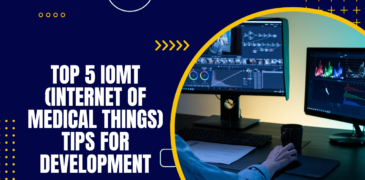The Internet of Medical Things (IoMT) represents a transformative frontier in healthcare, merging traditional medical devices with connectivity and data exchange capabilities. With IoMT, medical devices can seamlessly communicate, collect, and analyze patient data, enhancing diagnostics, treatment, and patient care. Developing IoMT solutions demands a delicate balance between innovation and reliability, as they must adhere to stringent regulatory standards while delivering cutting-edge functionality. In this dynamic landscape, developers must prioritize security, interoperability, and user privacy to ensure the integrity and trustworthiness of IoMT systems. This introduction sets the stage for exploring key strategies and considerations vital to successful IoMT development.
Prioritize Data Security
Prioritizing data security is paramount in the development of Internet of Medical Things (IoMT) solutions due to the sensitive nature of healthcare data and the potential risks associated with breaches. Developers must implement multifaceted security measures to safeguard patient information from unauthorized access, manipulation, or theft.
One key aspect of prioritizing data security is the implementation of robust encryption protocols throughout the data lifecycle, encompassing data at rest, in transit, and in use. Encryption ensures that even if data is intercepted or accessed illicitly, it remains unintelligible to unauthorized parties. Additionally, employing secure authentication mechanisms such as biometric authentication or multi-factor authentication helps to prevent unauthorized access to IoMT devices and associated data.
Moreover, developers should establish secure data transmission channels, utilizing technologies like Transport Layer Security (TLS) to encrypt data during transmission over networks.
Ensure Regulatory Compliance
Ensuring regulatory compliance is a cornerstone of developing Internet of Medical Things (IoMT) solutions. Given the stringent regulations governing the healthcare industry. Compliance with regulations such as the Health Insurance Portability and Accountability Act (HIPAA). General Data Protection Regulation (GDPR), and other regional or national standards is imperative to mitigate legal risks and uphold patient privacy and rights.
Developers must thoroughly understand the regulatory requirements applicable to IoMT solutions in the regions where they operate or intend to market their products. This includes not only familiarizing themselves with the specific provisions of each regulation. But also staying updated on any amendments or new directives that may impact their compliance obligations. Incorporating privacy-by-design principles into IoMT development processes can help ensure compliance from the outset. Documentation and record-keeping are crucial aspects of regulatory compliance. Developers should maintain comprehensive documentation of their compliance efforts, including risk assessments, security policies, and procedures for handling data breaches or regulatory inquiries.
Focus on Interoperability
Internet of Medical Things (IoMT) solutions, facilitating seamless communication and collaboration among diverse healthcare systems, devices, and platforms. By prioritizing interoperability, developers can overcome silos of information and enable the efficient exchange of data, thereby enhancing the quality and continuity of patient care.
To achieve effective interoperability, IoMT developers should adhere to established standards and protocols for data exchange and communication. Embracing widely accepted standards such as HL7 (Health Level Seven) and DICOM (Digital Imaging and Communications in Medicine) ensures compatibility and interoperability across various healthcare IT systems and medical devices.
Incorporate User-Centric Design
Incorporating user-centric design principles is paramount in the development of Internet of Medical Things (IoMT) solutions to ensure usability, efficiency, and satisfaction for both healthcare professionals and patients. By placing users at the forefront of the design process, developers can create IoMT devices and interfaces. That are intuitive, ergonomic, and aligned with user needs and preferences.
User research and feedback play a central role in informing the design of IoMT solutions. Conducting usability testing, focus groups, and interviews with end-users. It enable developers to gain insights into user workflows, pain points, and preferences. Guiding the development of user-friendly interfaces and functionalities.
Implement Continuous Monitoring and Updates
Implementing continuous monitoring and updates is essential in the development of Internet of Medical Things (IoMT) solutions to ensure ongoing performance, security, and compliance. By establishing mechanisms for real-time monitoring, developers can proactively detect anomalies, identify potential security threats, and monitor device performance.
Regular updates and patches are critical to addressing emerging security vulnerabilities. Mitigating risks, and ensuring the resilience of IoMT systems against evolving threats. Developers should establish streamlined processes for deploying updates. Including over-the-air (OTA) updates where applicable, to ensure timely distribution of patches and enhancements.
By prioritizing continuous monitoring and updates, developers can enhance the reliability, security, and longevity of IoMT devices. Safeguarding patient data and ensuring the delivery of high-quality healthcare services.
Conclusion
In conclusion, the development of Internet of Medical Things (IoMT) solutions demands a strategic approach that prioritizes data security. Regulatory compliance, interoperability, user-centric design, and continuous monitoring and updates. By adhering to these key principles, developers can navigate the complexities of IoMT innovation while ensuring the integrity, safety, and effectiveness of healthcare delivery. Embracing user needs, regulatory requirements, and technological advancements paves the way for the creation of IoMT solutions that empower healthcare professionals, improve patient outcomes, and drive positive change in the healthcare industry.
Read more:







